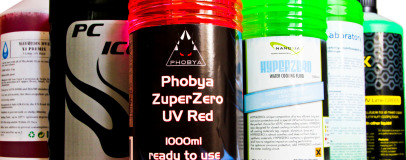
What's the best UV water-cooling coolant?
The world of watercooling is very different one to that which existed even five years ago. Off the shelf parts now number in their thousands, and the hobby itself has become even more popular too.
Even the coolant we use has picked up a fair amount of commercial spin. Gone are the days of using clear deionised or distilled water, mixed with some form of biocide (although many still prefer this). As well as dyes and additives, off-the-shelf pre-mixed coolants are becoming increasingly popular and are available in a wide range of colours, as well as UV, pearlescent and pastel shades, that offer a great way of making your water-cooled PC stand out from the rest.
However, it's a bit of a minefield when it comes to choosing the best coolant in terms of looks and performance, as each can vary out of the bottle in terms of UV reactivity or cooling performance. We've teamed up with Aquatuning, who has provided a stack of the latest pre-mixed coolants as well as a flow meter so we can see just how much difference there is. After all, if you're going for looks, a couple of degrees in your CPU temperature probably won't matter, as much as how awesome the coolant looks.
We're starting with six of the latest UV coolants from manufacturers such as Phobya, Mayhem's, EK and Nanoxia to see how they look under UV light and also how they perform in a modern water-cooling system. In the very near future, we'll also be back with a roundup of non-UV coolants where we'll throw all the results together to see who's the best in terms of performance.
Click to enlarge
Testing methods
To test each coolant's UV reactivity, we inserted an amount of each coolant into a sealed section of clear tubing and held this under UV light provided by two standard 12in cathodes. The test was undertaken in a darkened room to give a clear contrast between the best and worst performers in the test, but is still indicative of real-world lighting conditions inside your PC.
As you’d be a little crazy to water-cool your PC if it isn’t overclocked, we’ve used an Intel Core i5-2500K, which has been overclocked to 4.7GHz using vcore of 1.4V. The system was run with deionised water for a week to allow the thermal paste to cure.
We record the ambient room temperature to present the result as a delta T (the difference between the temperature of the CPU and the ambient temperature), to deal with any slight variations in the temperature in our testing environment. To measure flow rate, we used a Cole Palmer 120-1200LPH Flow Meter, reading results in litres per minute to obtain a more accurate reading given the meter is analogue. We filled the loop with deionised water to start with, then drained it, emptying each component, and filled the loop with the first coolant.
We then flushed each coolant out with deionised water, draining this as best we could between fills to ensure that there was no residual coolant left and only a minimal amount of deionised water – this is the best compromise between either leaving the loop drying for days on end or having six individual loops, which is clearly very impractical. We allowed each coolant to rid itself of air bubbles until none were visible in the coolant, tubes or audibly in the pump or blocks.

MSI MPG Velox 100R Chassis Review
October 14 2021 | 15:04









Want to comment? Please log in.